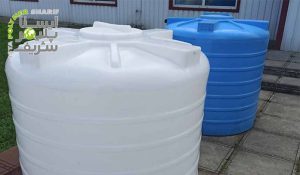Polyethylene (plastic) tanks are typically manufactured to be food-grade, making them suitable for long-term water storage. If the drinking water stored in these tanks develops an unpleasant taste, it could indicate several issues, including mold or algae growth. There are many ways to address this problem, but first, let’s discuss the reasons for the taste change in drinking water stored in polyethylene tanks and then explain the solutions.
Why Does Drinking Water in Polyethylene Tanks Taste Different?
Mold and algae can grow in your water tank under certain conditions. It is crucial to minimize light and air exposure to the water. Most plastic tanks are dark-colored, and it’s also advisable to avoid using transparent hoses for your filler pipes, vents, and outlets. Black food-grade hoses are the best.
To minimize air exposure, the tank should be filled completely during storage. Another reason for algae growth is storing impure water. Sometimes, you may need to fill your tanks from a river or another questionable source. If you use non-chlorinated water, it is recommended to rinse your tank before storage.
Why Does Water in Polyethylene Tanks Have a Strange Taste?
Have you ever taken a sip of water from your tank and noticed a strange taste? Sometimes, plastic can leach chemicals into the water, which might cause the odd taste. If you notice a taste change in your drinking water stored in a polyethylene tank, consider purchasing a different type of polyethylene tank to see if the taste improves.
Another possibility is that some substance has contaminated your water tank, such as bacteria or small pieces of food or dirt. If you suspect this, thoroughly clean your water tank with vinegar and hot water to see if the taste improves.
Finally, the issue might not be with your water at all. Sometimes, our sense of smell can trick us into thinking that our water tastes bad when it actually just smells bad. If you’re unsure whether the problem is with the taste or smell of your water, try holding your nose while drinking a sip. If the taste disappears, it might just be an illusion.
How to Change the Taste of Drinking Water in Polyethylene Tanks؟

One common source of introducing impurities and bad taste to your tank is the filler hose. Garden hoses are not food-grade, and constant exposure to sunlight can degrade them. The transfer of chemicals from the tank and plastic pipes is common and challenging to avoid. As long as you have food-grade plastic, it isn’t dangerous.
Changes in the taste of drinking water in polyethylene tanks are often seen in low-quality tanks. So, start by purchasing a suitable product. The most important thing is to use the water inside the tank frequently, so it doesn’t stay in the tank for too long. Also, avoid placing the tank in direct sunlight. Ensure all parts connected to the tank are made of food-grade plastic to prevent the water from tasting like plastic. Another method is to regularly clean the tank.
How to Clean a Polyethylene Tank؟
If your water tastes bad and you’ve traced the problem to the tank and plumbing, it’s a good idea to wash the entire tank. One effective method is to add about 1.2 cups of bicarbonate soda to your half-filled water tank and then add some vinegar. These substances will create a chemical reaction that is excellent for removing any deposits and biofilm accumulated in the tank.
Is the Taste of Water in Polyethylene Tanks Dangerous؟
We all know that water is essential for life. We need it for drinking, cooking, and cleaning. But what if the water we used made us sick? What if it tasted like plastic and contained harmful chemicals? Recent studies have shown that tank-stored water in the United States often contains high levels of lead, chlorine, and other contaminants.
Some scientists believe these contaminants may be responsible for a range of health problems, including cancer. So, what can you do to protect yourself and your family? The first step is to find a healthy water source; tap water can be a good option. Ultimately, you should fill your tank with mineral water, which is completely safe and problem-free.
Conclusion
Changes in the taste of drinking water in polyethylene tanks are rare if the tank is made from food-grade materials. Proper storage and regular cleaning of the tank are also recommended. Pay attention to the water inside the tank; if the water contains minerals and unhealthy substances, it can cause the water to taste bad. In any case, you can improve the water quality in your tank through three factors: first, buying a suitable tank, second, filling the tank with healthy water, and third, regularly cleaning the tank.






